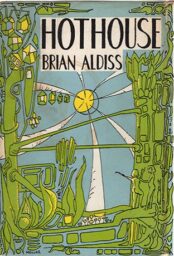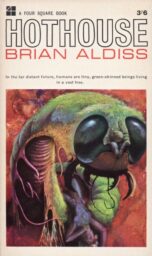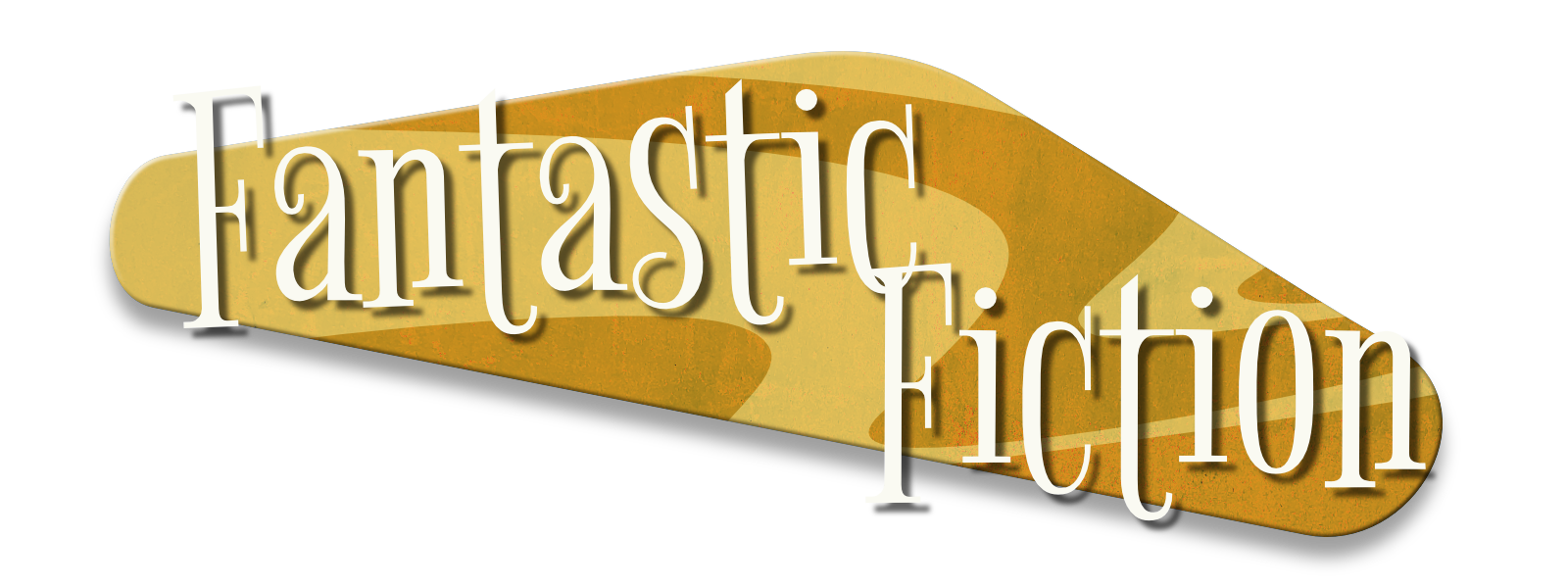 Originally published in five installments in The Magazine of Fantasy and Science Fiction in 1961, Hothouse was published as a novel and won the Hugo Award for short fiction (a little oddly) in 1962. It is not a book focused on character or plot—here the world is everything, and it is an often bizarre, sometimes frightening place to travel through.
Originally published in five installments in The Magazine of Fantasy and Science Fiction in 1961, Hothouse was published as a novel and won the Hugo Award for short fiction (a little oddly) in 1962. It is not a book focused on character or plot—here the world is everything, and it is an often bizarre, sometimes frightening place to travel through.
In the far, far future, the sun is burning larger and hotter, and the Earth has stopped spinning, so that one side always faces the sun while the other remains dark and cold. On this future Earth, the sun-warmed side is a riotous mass of vegetation dominated by one vast banyan tree, and within the jungle formed by the banyan’s “interlaced scaffolding,” an ongoing battle for sustenance is waged between the many and various alien-like lifeforms.
 Humanity is an insignificant survivor in this world. Small bands of people, who are far smaller in stature than we are now and green-skinned, live in the jungle and die easily. Everything is food for everything else. Most plants are now omnivorous and have evolved in fantastical ways, developing camouflage and lures to draw food to them or becoming mobile in order to follow where food goes, often taking on insect and animal characteristics such as seen in the traversers, spider-like plants that cast webs between the Earth and the Moon, the wiltmilts who have long sticky tongues something like a chameleon’s (as do the giant flying seeds known as suckerbirds), and the killerwillows that hide beneath the sand, their roots now muscular tentacles for snaring food.
Humanity is an insignificant survivor in this world. Small bands of people, who are far smaller in stature than we are now and green-skinned, live in the jungle and die easily. Everything is food for everything else. Most plants are now omnivorous and have evolved in fantastical ways, developing camouflage and lures to draw food to them or becoming mobile in order to follow where food goes, often taking on insect and animal characteristics such as seen in the traversers, spider-like plants that cast webs between the Earth and the Moon, the wiltmilts who have long sticky tongues something like a chameleon’s (as do the giant flying seeds known as suckerbirds), and the killerwillows that hide beneath the sand, their roots now muscular tentacles for snaring food.
Aldiss’ vision of a deadly jungle in which vegetation is rife and everything is both predator and prey, every step potentially fateful, was fed by his wartime experiences in Burma. And characters certainly die with little or no spectacle, with the survivors saying only that “it is the way”—as their companions stumble into the mouths of waiting plants or are run through by giant wasp-like creatures—before stepping around and moving on. There can be no heroes or heroines in such a place because there is no way to overcome the larger obstacles posed by a world overrun with competing dangers—human life is utterly trivial in such a setting.
 The characters we meet are therefore little more than names. Gren is the only consistent company for the reader, and even he, though a bolder and more inquisitive creature than his fellows, is driven by simple, barely understood instincts most of the time. His odyssey across half the world is less about him than it is the reader’s exploration of this future Earth with Aldiss playing guide, pointing out as many of the weird and wonderful things he’s thought up as he can, such that we encounter mutated people who have grown wingsuit-like skin between their arms and legs, a sentient fungus, giant insects who keep pet cats (sort of), angry seaweed, and a talking dolphin who prophesies the end of the world while carried about by a bent-backed old man. Yes, we may enjoy the scenery as we follow Gren’s journey; he simply aims to survive it.
The characters we meet are therefore little more than names. Gren is the only consistent company for the reader, and even he, though a bolder and more inquisitive creature than his fellows, is driven by simple, barely understood instincts most of the time. His odyssey across half the world is less about him than it is the reader’s exploration of this future Earth with Aldiss playing guide, pointing out as many of the weird and wonderful things he’s thought up as he can, such that we encounter mutated people who have grown wingsuit-like skin between their arms and legs, a sentient fungus, giant insects who keep pet cats (sort of), angry seaweed, and a talking dolphin who prophesies the end of the world while carried about by a bent-backed old man. Yes, we may enjoy the scenery as we follow Gren’s journey; he simply aims to survive it.


Thanks for writing about this. I think it’s a classic, although I have read the “Hothouse” novelette part much more recently than the entire fix-up novel. It’s a great story, although the novelette gave a modest insight into the novel. A great story of the far future, with man almost extinct on Earth under the onslaught of the vegetable Kingdom and other surviving insects. The mood and tone are outstanding. I read an interesting introduction/essay by Joseph Milicia in the 1984 Baen version of “Hothouse”, which is extensive and informative, although perhaps a bit more than I needed to know.
Ah, I think we have the same Baen copy – I also read Joseph Milicia’s introductory essay. 👍
I definitely enjoyed this a lot, especially for its weirdness, and it’s become a favourite of mine out of the vintage sci-fi I’ve read so far.
@seattlein2025 sounds a bit like this year's Hugo novel finalist, Alien Clay! Minus the revolutionary elements.
I read the short story over 55 years ago and a little later the book. Left a mark on me that time has not erased. When LA burned this year, I kept thinking of it. Great story.